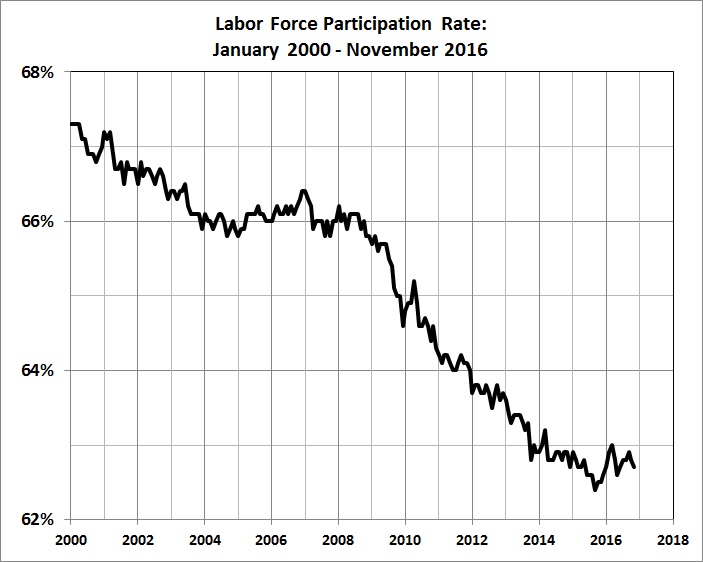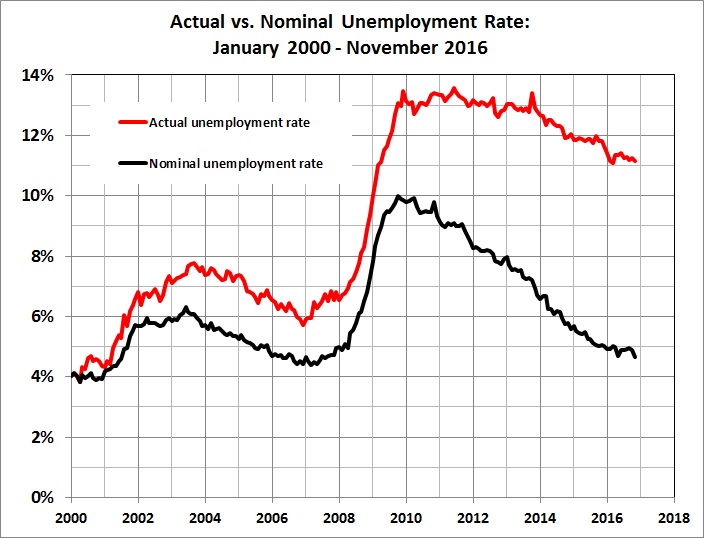REVISED AND UPDATED 12/02/16 — A COMPANION PIECE TO “ECONOMIC GROWTH SINCE WORLD WAR II” (REVISED AND UPDATED 05/31/16)
By the measure of real unemployment, the Great Recession is still with us. Nor is it likely to end anytime soon, given the anti-business and anti-growth policies and rhetoric of the Obama administration.
Officially, the unemployment rate stands at 4.6 percent, as of November 2016. Unofficially — but in reality — the unemployment rate stands 6.6 percentage points higher at 11.2 percent. While the official unemployment rate has dropped by 5.4 percentage points from its peak in 2009, the real unemployment rate has dropped by only 2.3 percentage points since then.
No amount of “stimulus” or “quantitative easing” will create jobs when employers and entrepreneurs are loath to take the risk of expanding and starting businesses, given Obama’s penchant for regulating against success and taxing it when it is achieved. The job-killing effects of Obamacare will only worsen the situation. And, of course, taxing “the rich” is a sure way to hamper economic growth by stifling productive effort, innovation, and investment.
How can I say that the real unemployment rate is 6.6 percentage points above the real rate? Easily. Just follow this trail of definitions, provided by the official purveyor of unemployment statistics, the Bureau of Labor Statistics:
Unemployed persons (Current Population Survey)
Persons aged 16 years and older who had no employment during the reference week, were available for work, except for temporary illness, and had made specific efforts to find employment sometime during the 4-week period ending with the reference week. Persons who were waiting to be recalled to a job from which they had been laid off need not have been looking for work to be classified as unemployed.Unemployment rate
The unemployment rate represents the number unemployed as a percent of the labor force.Labor force (Current Population Survey)
The labor force includes all persons classified as employed or unemployed in accordance with the definitions contained in this glossary.Labor force participation rate
The labor force as a percent of the civilian noninstitutional population.Civilian noninstitutional population (Current Population Survey)
Included are persons 16 years of age and older residing in the 50 States and the District of Columbia who are not inmates of institutions (for example, penal and mental facilities, homes for the aged), and who are not on active duty in the Armed Forces.
In short, if you are 16 years of age and older, not confined to an institution or on active duty in the armed forces, but have not recently made specific efforts to find employment, you are not (officially) a member of the labor force. And if you are not (officially) a member of the labor force because you have given up looking for work, you are not (officially) unemployed — according to the BLS. Of course, you are really unemployed, but your unemployment is well disguised by the BLS’s contorted definition of unemployment.
What has happened is this: Since the first four months of 2000, when the labor-force participation rate peaked at 67.3 percent, it has declined to 62.7 percent:

Source: See next graph.
Why the decline, which had came to a halt during G.W. Bush’s second term but resumed in late 2008? The slowdown of 2000 (coincident with the bursting of the dot-com bubble) and the shock of 9/11 can account for the decline from 2000 to 2004, as workers chose to withdraw from the labor force when faced with dimmer employment prospects. But what about the sharper decline that began near the end of Bush’s second term?
There we see not only the demoralizing effects of the Great Recession but also the lure of incentives to refrain from work, namely, extended unemployment benefits, the relaxation of welfare rules, the aggressive distribution of food stamps, and “free” healthcare” for an expanded Medicaid enrollment base and 20-somethings who live in their parents’ basements.* Need I add that both the prolongation of the Great Recession and the enticements to refrain from work are Obama’s doing? (That’s on the supply side. On the demand side, of course, there are the phony and even negative effects of “stimulus” spending, the chilling effects of regime uncertainty, which has persisted beyond the official end of the Great Recession, and the expansion of government spending.)
If the labor-force participation rate had remained at its peak of 67.3 percent, so that the disguised unemployed was no longer disguised, the official unemployment rate would have reached 13.5 percent in December 2009, as against the nominal peak of 10 percent in October 2009. Further, instead of declining to the phony rate of 4.6 percent in November 2016, the official unemployment rate would have stayed almost constant — hovering between 11 percent and 13.5 percent.
The growing disparity between the real and nominal unemployment rates is evident in this graph:

Derived from Series LNS12000000, Seasonally Adjusted Employment Level; Series LNS11000000, Seasonally Adjusted Civilian Labor Force Level; and Series LNS11300000, Seasonally Adjusted Civilian labor force participation rate. All are available at BLS, Labor Force Statistics from the Current Population Survey.
_________
* Contrary to some speculation, the labor-force participation rate is not declining because older workers are retiring earlier. The participation rate among workers 55 and older rose steadily from 1994 to 2014. The decline is concentrated among workers under the age of 55, and especially workers in the 16-24 age bracket. (See this table at BLS.gov.) Why? My conjecture: The Great Recession caused a shakeout of marginal (low-skill) workers, many of whom simply dropped out of the labor market. And it became easier for them to drop out because, under Obamacare, many of them became eligible for Medicaid and many others enjoy prolonged coverage (until age 26) under their parents’ health plans.

* * *
Related reading:
Randall Holcombe, “Long-Term Unemployment Benefits Expire; Long-Term Unemployment Falls,” Mises Economics Blog, September 10, 2014
Arnold Kling, “The State of the Economy,” askblog, October 12, 2014
Stephen Moore, “Why Are So Many Employers Unable to Fill Jobs?” The Daily Signal, April 6, 2015
Related posts: See the list here.
